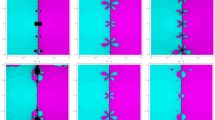Summary
In this paper a new numerical method for finding approximate solutions of the torsion problem is proposed. The method takes full advantage of the theory of analytic complex functions. A new potential function directly in terms of shear stresses is proposed and expanded in the double-ended Laurent series involving harmonic polynomials. A novel element-free weak form procedure, labeled line element-less method (LEM), has been developed imposing that the square of the net flux across the border is minimal with respect to coefficients expansion. Numerical implementation of the LEM results in systems of linear algebraic equations involving symmetric and positive-definite matrices without resorting to any discretization neither in the domain nor in the boundary. Some numerical applications are reported to demonstrate the efficiency and accuracy of the method.
Similar content being viewed by others
References
Zienkiewicz O.C. (1984). The Finite Element Method in Engineering Science. McGraw-Hill, New York
Katsikadelis J.T. (2002). Boundary Elements: Theory and Applications. Elsevier, UK
Bonnet M., Maier G. and Polizzotto C. (1998). Symmetric Galerkin boundary element method. Appl. Mech. Rev. 51: 669–704
Davì G. and Milazzo A. (1994). A symmetric and positive definite variational BEM for 2-D free vibration analysis. Engng. Anal. Bound. Elem. 14: 343–348
Davì G. and Milazzo A. (1997). A symmetric and positive definite BEM for 2-D forced vibrations. J. Sound Vib. 206(4): 611–617
Davì G. and Milazzo A. (1997). A new symmetric and positive definite boundary element formulation for lateral vibration of plates. J. Sound Vib. 206(4): 507–521
Panzeca T., Cucco F. and Terravecchia S. (2002). Symmetric boundary element method versus finite element method. Comput. Methods Appl. Mech. Engng. 191(31): 3347–3367
Liu G.R. and Gu Y.T. (2000). Coupling element free Galerkin and hybrid boundary element methods using modified variational formulation. Comput. Mech. 26: 166–173
Gu Y.T. and Liu G.R. (2001). A meshless local Petrov–Galerkin (MLPG) method for free and forced vibration analyses for solids. Comput. Mech. 27: 188–198
Liu G.R. and Gu Y.T. (2001). A local point interpolation method for stress analysis of two-dimensional solids. Int. J. Struct. Engng. Mech. 11: 221–236
Herrmann R.L. (1965). Elastic torsional analysis of irregular shapes. ASCE J. Engng. Mech. Div. 91(EM6): 11–9
Mason W.E. and Herrmann R.L. (1968). Elastic shear analysis of general prismatic shaped beams. ASCE J. Engng. Mech. Div. 94(EM4): 965–83
Jawson M.A. and Ponter A.R. (1963). An integral equation solution of the torsion problem. Proc. R. Soc. Lond. 275(A): 237–46
Friedman Z. and Kosmatka J.B. (2000). Torsion and flexure of a prismatic isotropic beam using the boundary element method. Comput. Struct. 74: 479–494
Gaspari D. and Aristodemo M. (2005). Torsion and flexure analysis of orthotropic beams by a boundary element model. Engng. Anal. Bound. Elem. 29: 850–858
Petrolo A.S. and Casciaro R. (2004). 3D beam element based on Saint Venànt’s rod theory. Comput. Struct. 82: 2471–2481
Muskhelishvili N.I. (1963). Some Basic Problems of the Mathematical Theory of Elasticity, 4th ed. P. Noordhoff, Groningen
Ziegler F. (1998). Mechanics of Solid and Fluids, 2nd reprint of 2nd ed. Springer, New York
Timoshenko S.P. and Goodier J.N. (1970). Theory of Elasticity, 3rd ed. McGraw-Hill, New York
Author information
Authors and Affiliations
Corresponding author
Additional information
Dedicated to Professor Franz Ziegler on the occasion of his 70th birthday
Rights and permissions
About this article
Cite this article
Di Paola, M., Pirrotta, A. & Santoro, R. Line element-less method (LEM) for beam torsion solution (truly no-mesh method). Acta Mech 195, 349–364 (2008). https://doi.org/10.1007/s00707-007-0557-2
Received:
Accepted:
Published:
Issue Date:
DOI: https://doi.org/10.1007/s00707-007-0557-2




